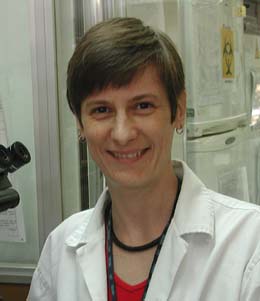Manuela da Silva
Curriculum Vitae
Português
Personal details. Portuguese-Dutch, female.
Qualifications. BSc: Biology, Universidade Estadual Paulista, Rio Claro, Brazil, 1991. MSc: Food Science, Universidade Estadual de Campinas, Campinas, Brazil, 1996. PhD: Food Science, Universidade Estadual de Campinas, Campinas, Brazil, 2002.
Professional experience
Since August 2002, Federal Government Specialist, Instituto Nacional de Controle de Qualidade em Saúde, Fundação Oswaldo Cruz, INCQS/FIOCRUZ, Rio de Janeiro, RJ, Brazil. Identification and preservation of fungi from environmental and clinical samples; research on fungal degradation of pollutants, fungal diversity, fungal deterioration and their elimination by gamma radiation.
March 2006 to present, collaboration with the Instituto Nacional de Propriedade Industrial (INPI, Rio de Janeiro, RJ, Brazil) on the implementation and organization of the Centro Brasileiro de Material Biológico, the first Brazilian centre for depositing biological material for patent purposes.
August to December 2000 and May to August 2001, visiting researcher at the National Center for Toxicological Research (Food and Drug Administration, FDA/NCTR, USA) carrying out research on fungal degradation of polycyclic aromatic hydrocarbon supervised by Dr Carl Cerniglia.
September 1993 to May 1994, at the Fundação Tropical de Pesquisas e Tecnologia André Tosello (FTPTAT, Campinas, SP, Brazil), Implementing a database Fungi of Brazil described by Batista and co-workers.
Projects. September 2005 to date, Isolation of fungi from marine environment, taxonomic characterization and evaluation of their biotechnological potential (Coleção Brasileira de Microrganismos de Ambiente e Indústria, CBMAI, UNICAMP, Campinas State University, SP, Brazil). March 2004 to date, Study of degradation of industrial dyes by fungi isolated from sediment (Microbiology Department, INCQS, Fundação Oswaldo Cruz, FIOCRUZ, RJ, Brazil). January 2004 to December 2005, Fungi that deteriorate paper material and their elimination by gamma radiation (Microbiology Department, INCQS, Fundação Oswaldo Cruz, FIOCRUZ, RJ, Brazil).
Languages. Portuguese (fluent reading, writing and conversation), English (fluent reading, writing and conversation), French (fluent reading and conversation), Spanish (moderate reading and conversation).
Dra M. da Silva,

Fundação Oswaldo Cruz - FIOCRUZ,
National Institute for Health Quality Control – INCQS,
Microbiology Department, Fungi Section,
Av. Brasil 4365,
Manguinhos - Rio de Janeiro,
21045900, RJ – Brazil
Telephone: +55 (21) 3865 5186

Institute website: www.incqs.fiocruz.br
Experience abroad. March 1992 to August 1993, development of a preliminary checklist of Brazilian fungi, Fungi from Brazil Described by Batista and Co-workers (former International Mycological Institute, Egham, Surrey, UK, now CABI, funded by CNPq, supervisors: Dr D.W. Minter, Dr B.C. Sutton). February to August 1993, investigation of possible applications of fatty acids profiles in the taxonomy of fungi from Mucorales order, using the MIDI system with gas-liquid chromatography (former International Mycological Institute, Egham, Surrey, UK, now CABI, funded by CNPq, supervisors: Dr P. Bridge, Dr P.M. Kirk and Dr G. Saddler)